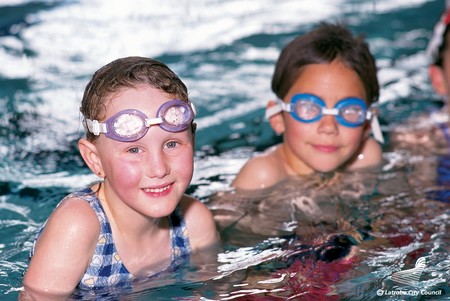If the water is shallow, a good method is to have the children kneel down with their arms outstretched, take a deep breath, and gently fall forward. Or, if the water is above their head, stand facing them and hold their arms, making sure that their legs are outstretched and that they are lying on their tummy flat on top of the water. The first time you do that, tell the child, “I want you to take a deep breath and put your face in the water. I’m going to count to five and will let you go while you are under the water, and when you run out of breath I’m going to fish you out.”
By this time the relationship between the teacher and pupil should be so good that the child will know that he can trust the teacher, and that I she says, “I will fish you out,” she really means it. The best way to do this is to have the child touch your shoulders while your free hands are supporting his hips. At the word “Go,” he goes under, lets your shoulders go a couple of inches, and for a few short seconds he feels the sensation of floating for the first time in his life.
If it goes without a hitch, praise him profusely. Repeat this a few times, then let him stand in the shallow part of the pool if there is one while you stand back in the deeper part, at first just a few feet away. Hold your arms out, ready to catch him, and say, “You try to float here to me.” As time goes on, you can increase the distance between you and the child.
The next step is to get them paddling with their faces in the water. This should be done without their bubbles on, which is a bit of a drawback initially because they are used to having them on their backs. At the start they will still tend to kick their legs downward.
Tell them to take a deep breath, face in the water, and move their arms in a circular movement while kicking their legs. Walk backwards away from them; as you do so, you create a vacuum in front of you. The quicker you walk the stronger the vacuum will be. The children are sucked into it and it gives them a much greater speed than if they swam entirely on their own.
When you feel they need to come up for air, lift their head above the water by putting a hand under their chin. After taking a breath they should go down again. Keep repeating this until they get used to the idea. With this age group, I still don’t insist on blowing bubbles out or holding their breath. Some will blow their breath out, whereas some will hold on to their breath, so that when they come up to the surface they will let the air out before inhaling again. This is the time when a teacher needs to have ten arms instead of two. There are so many faults to correct, it is much better to make corrections by touch rather than lengthy verbal instructions. You can also let them experience some home swimming lessons for them to learn more.
If their legs are trailing too low, lift them up a bit by pushing their hips in. If they tend to splash out with their arms, push the arms down. If they forget to come up for air, give a little tap on the top of the head or lift the chin up. Gently correct and nudge them as required.
Some children get a little too game at this stage, so, as you are taking one child at a time, keep looking back at the other three. If one child keeps on jumping into the deep end and has difficulty in getting back to the shallow part, put a bubble back on as a safety measure and then take the bubble off when he is getting personal instruction from you.
Please don’t discourage the children from having little tryouts on their own. Don’t ridicule them if they can’t get back on their own to the edge of the pool. Just walk over nonchalantly and lift them up without saying a word.
